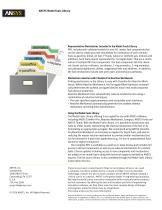
Catalog excerpts

ANSYS Model Fuels Library The Model Fuels Library: Accurate Combustion Chemistry for the Real World • Detailed, well-validated fuel models for accurate simulation • More than 65 master fuel components for a wide range of operating conditions Today’s engine and combustor designers are striving to attain low emissions and high efficiency more rapidly and at a lower cost than ever before. Combustion modeling can generate substantial savings in engine development cost and improved product quality. But challenges in achieving these benefits often arise due to inaccuracies in the fuel model. Engine designers have traditionally used severely reduced fuel models in combustion simulations. These models can require complicated tuning or adjustment in order to provide predictive results. Alternatively, advanced combustion simulation tools like ANSYS Forte and ANSYS Chemkin-Pro can take advantage of larger and more accurate fuel models and still provide fast time-to-solution. The Model Fuels Library provides a set of accurate real-fuel models that are easy to use in modern tools. The Model Fuels Library (MFL) includes detailed and validated reaction mechanisms for over 65 fuel components that are relevant to combustion simulations in a wide variety of industrial and commercial applications. The fuel components can be used to represent gaseous or liquid fuel combustion for petroleum-derived or alternative fuels. Gaseous components include natural gas, synthetic gas, biofuels and blends. For liquid fuels, the fuel components can be used in formulating surrogates for a wide range of real-world fuels, including gasoline, diesel, jet fuel, alternative fuels, fuel blends and additives. The reaction mechanisms are suitable for many combustion applications, including spark-ignition engines, compression-ignition engines, gas- and liquid-fired turbine combustors, boilers, flares and furnaces. The mechanisms have been extensively validated for operating conditions covering a wide range of pressures, temperatures, equivalence ratios and dilutions. The mechanisms are constructed in a self-consistent manner and follow a raterule–based approach for liquid components that results in predictive capabilities for the mechanisms. The predictive capabilities of library mechanisms are not limited to combustion characteristics of fuels, but also include fuel effects on emissions, along with soot particle size and number densities. The Model Fuel Library is based on both the outcome of the industry-driven Model Fuels Consortium (2006-2012) project and the ongoing Model Fuels Library Subscription Service that maintains the Library to keep it up to date with the state of current combustion scienc
Open the catalog to page 1
ANSYS Model Fuels Library Representative Mechanisms Included in the Model Fuels Library MFL includes well validated models for over 65. master fuel components that can be used to create accurate simulations for combustion of such common fuels as gasoline, diesel, jet fuel, FT fuels, natural or synthetic gas, biofuels and additives. Such fuels may be represented by “surrogate fuels” that are a combination of multiple MFL fuel components. The fuel components fall into chemical classes such as n-alkanes, iso-alkanes, 1-ring aromatics, 2-ring aromatics, cycloalkanes/naphthenes, olefins,...
Open the catalog to page 2All ANSYS catalogs and technical brochures
-
Explicit Dynamics
8 Pages
-
Ansys SpaceClaim Direct
2 Pages
-
Ansys SCADE Display
5 Pages
-
Ansys SCADE Test
4 Pages
-
ANSYS Twin Builder
1 Pages
-
ANSYS VRXPERIENCE
4 Pages
-
ANSYS® Simplorer® 17
5 Pages
-
ANSYS FENSAP-ICE TURBO
8 Pages
-
ANSYS FENSAP-ICE
4 Pages
-
ANSYS Forte
4 Pages
-
Chemkin-Pro
6 Pages
-
Polyflow
8 Pages
-
ANSYS® SCADE LifeCycle® 17.0
2 Pages
-
ANSYS® SCADE Suite® 17.0
7 Pages
-
ANSYS Maxwell
2 Pages
-
ANSYS DesignXplorer
8 Pages
-
Meshing Solutions
4 Pages
-
ANSYS Q3D Extractor
2 Pages
-
ansys-icepak-brochure
8 Pages
Archived catalogs
-
ANSYS HFSS
2 Pages
-
ANSYS AIM
2 Pages
-
Discovery
2 Pages
-
ANSYS SpaceClaim
2 Pages
-
ANSYS AIM
2 Pages
-
turbomachinery
4 Pages
-
ANSYS® SCADE Display® 17.0
6 Pages
-
ANSYS® SCADE System® 17.0
6 Pages
-
ANSYS SIwave
2 Pages
-
ANSYS SpaceClaim
2 Pages
-
Hybrid Electric Powertrain
2 Pages
-
High-Performance Computing
8 Pages
-
ANSYS® SCADE Test™ 17.0
4 Pages
-
ANSYS Structural
2 Pages
-
SCADE System ® R16
5 Pages
-
EMIT
5 Pages
-
ANSYS 17.0 Capabilities
19 Pages
-
Fluid Dynamics
8 Pages
-
Electromagnetics
12 Pages
-
ANSYS Meshing Solutions
4 Pages
-
Ansys brochure
12 Pages
-
SIwave
12 Pages
-
Q3D Extractor
8 Pages
-
Fatigue Products
8 Pages
-
Icepak
8 Pages
-
TGrid
4 Pages
-
ANSYS Workbench Platform
4 Pages
-
SCADE LifeCycle
3 Pages
-
SCADE Display
4 Pages
-
SCADE Suite
5 Pages
-
SCADE System
3 Pages
-
ANSYS Simplorer
8 Pages
-
Systems & Multiphysics Solutions
12 Pages
-
ANSYS Mechanical Products
12 Pages
-
ANSYS Vista TF
2 Pages
-
ANSYS AQWA
4 Pages
-
ansys-fluent-brochure
12 Pages
-
ansys-maxwell-brochure
8 Pages
-
ansys-hfss-brochure
12 Pages
-
ansys-cfx-brochure
4 Pages
-
ANSYS Composite PrepPost
2 Pages
-
ANSYS ASAS
4 Pages
-
FLUENT® for CATIA® V5
4 Pages




































































